Introduction
The Senses
Have you ever considered how you experience the world around you? We rely on our senses to understand the world around us, from the sounds we hear to the sights we see and the smells that surround us.
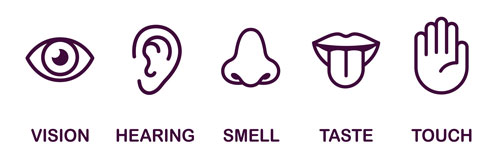
Introduction
In this lesson, you will learn how sensory signals are transmitted to the brain for all five senses and what factors determine whether or not we actually detect a sensory stimulus. In addition, you will learn about how and why you feel pain and why a merry-go-round can be so disorienting!

Following successful completion of this lesson, students will be able to...
- Explain how the process of sensation is related to behavior and mental processes.
- Explain how the structures and functions of the visual sensory system relate to behavior and mental processes.
- Explain how the structures and functions of the auditory sensory system relate to behavior and mental processes.
- Explain how the structures and functions of the chemical sensory systems relate to behavior and mental processes.
- Explain how the structures and functions of the touch sensory system relate to behavior and mental processes.
- Explain how the structures and functions of the pain sensory system relate to behavior and mental processes.
- Explain how the structures and functions that maintain balance (vestibular) and body movement (kinesthetic) relate to behavior and mental processes.
Topic
- 1.6 Sensation
Essential Knowledge
- 1.6.A.1 Sensation is the process of detecting information from the environment that meets a certain threshold and transducing stimuli into neurochemical messages for processing (perception) in the brain. The absolute threshold occurs when a stimulus can be detected at least 50% of the time.
- 1.6.A.2 Detection of change in stimuli or diminished sensitivity to stimuli can be explained by the just-noticeable difference and sensory adaptation. Weber's law describes the degree to which stimuli need to be different for the difference to be detected.
- 1.6.A.3 The sensory systems constantly work together in a process called sensory interaction. Synesthesia is an experience of sensation in which one system of sensation is experienced through another.
- 1.6.B.1 The retina is the photosensitive surface at the back of the eye. Cells in the retina capture visual information that is transduced to the brain for processing. Evidence of incomplete images captured by the retina is demonstrated by the presence of the blind spot, where the visual nerve exits the eye. The brain fills in the gaps in the incomplete retinal images to perceive a relatively complete picture of the world.
- 1.6.B.2 Visual stimuli are focused onto the retina by the lens via a process called accommodation. When this process is altered, nearsightedness or farsightedness can result.
- 1.6.B.3 Cells that lie in the periphery of the eye and detect shapes and movement, but not color, are called rods. These cells are mainly activated in low-light environments. These cells play a role in light and dark adaptation.
- 1.6.B.4 Color vision is explained by both the trichromatic theory and the opponent-process theory.
- Photoreceptor cells located in the fovea of the eye that process color and detail are called cones. Researchers have identified blue (detecting short wavelengths), green (detecting medium wavelengths) and red (detecting long wavelengths) cones in the retina.
- After images result when certain ganglion cells in the retina are activated while others are not. The ganglion cells involved in this opponent process are red/green, blue/yellow/ and black/white.
- Color vision deficiency involves damage or irregularities to one or more cones or ganglion cells (red/green, blue/yellow). Color vision deficiency includes dichromatism or monochromatism.
- 1.6.B.5 Damage to parts of the brain responsible for vision (mainly the occipital lobes) can result in disorders such as prosopagnosia (face blindness) and blindsight.
- 1.6.C.1 Sound occurs through the movement of air molecules at different wavelengths (called pitch) and amplitudes (called loudness).
- 1.6.C.2 Theories that help explain pitch perception include place theory, volley theory, and frequency theory.
- 1.6.C.3 Sound localization describes how we identify where sounds in our environment are coming from.
- 1.6.C.4 Hearing difficulties can result from aging and various kinds of damage to auditory structures. Types of hearing loss include conduction deafness and sensorineural deafness.
- 1.6.D.1 Structures in the nose and brain process and/or transduce olfactory stimuli. Smell is the only sense not processed first in the thalamus of the brain. Pheromones produce chemical messages for the olfactory system.
- 1.6.D.2 Gustation is the sense of taste, and types of tastes include sweet, sour, salty, bitter, umami, and oleogustus.
- 1.6.D.3 Structures in the tongue, mouth, and brain process and/or transduce basic tastes. The number of taste receptors on the tongue is related to how sensitive people are to tastes, classifying them as supertasters, medium tasters, or nontasters.
- 1.6.D.4 The chemical senses interact to create the sensation of taste. Without the sense of smell, taste sensations are either muted or not experienced.
- 1.6.E.1 Structures within the skin and brain process and/or transduce touch stimuli. The sensation of "hot" is produced by the activation of warm and cold receptors in the skin.
- 1.6.F.1 Pain is processed both in the body and in the brain. Gate control theory is one attempt to describe the complexities of pain. Phantom limb sensation occurs when people who have lost limbs report sensation or pain where the limb used to be.
- 1.6.G.1 The vestibular sense controls balance and is primarily detected by the semicircular canals and structures in the brain.
- 1.6.G.2 Kinesthesis the sense of one's body movement. Kinesthesis allows the body to move in coordinated ways without having to look at the various parts of the body as it moves.
Science Practice
- 1.A Apply psychological perspectives, theories, concepts, and research findings to a scenario.
- 3.A Identify psychology related concepts in descriptions or representations of data
- 3.C Interpret quantitative or qualitative inferential data from a given table, graph, chart, figure, or diagram
The above objectives correspond with the AP Psychology CED standards: 1.6.A, 1.6.B, 1.6.C, 1.6.D, 1.6.E, 1.6.F, 1.6.G.
What is Sensation?
Sensation
Sensation is the process by which our brain and nervous system receive input from the environment through our five senses- sight, hearing, touch, taste, and smell. Our brains then perform a process known as transduction, in which one form of energy is converted to another.
In vision, for example, the light energy we take in through our eyes is then transduced into a neural signals that our brain can interpret and process to determine what we are seeing. But how do we actually detect a stimulus and what happens when we don't?
The Senses
Absolute thresholds are the lowest level of awareness of a faint stimuli with no competing stimuli present. In order to pass the absolute threshold, the stimulus has to be detected at least 50% of the time. Read further to learn more about the absolute thresholds for your five senses.
Touch
You can detect a teaspoonful of sugar diluted in a gallon of water.
Sight
You can detect a drop of perfume diffused in a three-room apartment.
Hearing
You can register a watch ticking from 20 feet away in an otherwise quiet environment.
Taste
You can see a candle's flame from 30 miles away on a perfectly dark night, but no farther than that.
Smell
You can detect a drop of perfume diffused in a three-room apartment.
Ernst Weber
Ernst Weber was a German physician who used experimental techniques to study psychophysics, the relationship between a stimulus and our response to it. In his research he found that while we can detect a difference between two sensory stimuli, we cannot determine the degree of difference.
For example, we can tell two items have different weights (based on the pressure of the touch) but not the degree to which their weights vary. However, Weber discovered that the greater the difference between the two stimuli, the easier it is to discriminate between them.
Weber looked for the smallest amount two stimuli had to differ for us to be able to tell them apart. This became known as the difference threshold, or the just noticeable difference (JND). According to this principle, also now known as Weber's Law, two stimuli must differ by a constant percentage of the original stimulus intensity, not by a constant amount.
For example, to detect a difference in weight, two stimuli must differ by at least 3%; to detect a difference in tone, the frequency of the tones must differ by at least 0.3%; to detect a difference in light, the two stimuli must differ in intensity by at least 8%.
Sensory Adaptation
Sometimes there are other factors that affect whether we can detect a stimulus. For example, if you have a pet but your friend does not, can they immediately smell your cat or dog when you cannot? The answer is likely yes due to the phenomenon of sensory adaptation.
Sensory adaptation occurs when your sensory receptors respond less to a familiar or unchanging stimulus. You may recall a popular air freshener commercial that depicted people who have gone "noseblind" to the smells of their house or car. This would be an example of sensory adaptation.
Multiple Senses
Your senses also work in concert with one another, and it is rare that you experience a stimulus through only one sense.
For example, the sense of taste is heavily influenced by the sense of smell which you have probably experienced if you've ever had a cold and your nasal passages were blocked- food probably didn't seem to taste like anything. This is known as sensory interaction and we experience it in a variety of ways other than those involving taste and smell.
You may have also noticed that using the "Closed Captioning" function on your TV allows you to keep the volume very low but still "hear" the words being spoken. In reality, you are using both your sense of sight and hearing together.
Synesthesia
Some people experience a different form of sensory interaction known as synesthesia. Synesthesia is a condition in which the stimulation of one sense will automatically trigger the stimulation of another sense and it affects roughly 2-4% of the population.
Common examples of the sensory interaction a synesthete (a person with synesthesia) experiences would be experiencing smells while seeing certain numbers or hearing certain musical notes.
Textbook Reading #1
Read 5.1 Sensation versus Perception in your Psychology 2e textbook from OpenStax to review the concepts featured in this section of the lesson, but be aware that many of the perceptual concepts featured in the reading will not be covered until the next unit.
5.1 Sensation versus Perception
- Online Textbook
- PDF Version - pgs. 146-149
Visual Processing
It may come as no surprise to you, but humans use vision more than any of the other senses. In fact, a very large portion of our brain is devoted entirely to processing visual input. You have already learned about the concept of transduction in which energy is converted from one form into another. In the case of vision, transduction transforms electromagnetic light waves into an electrochemical neural code our brains can interpret and understand.
Energy moves in waves in the electromagnetic spectrum and each type of energy has a different wavelength, the distance from the peak of one wave to the next. The intensity of a wave is determined by its amplitude, or height.
Colors
This is the portion of the spectrum of electromagnetic energy spectrum visible to the human eye. From left to right, the wavelengths get shorter, so our experience of the color red is associated with longer wavelengths than our experience of the color violet. The intensity or brightness of the color is determined by its amplitude. You may have already learned the acronym ROY G. BIV, which represents the colors in order by wavelength, or red, orange, yellow, green, blue, indigo, violet.

Textbook Reading #2
Read 5.2 Waves and Wavelengths in your Psychology 2e textbook from OpenStax to review the concepts featured in this section of the lesson, but be aware that many of the perceptual concepts featured in the reading will not be covered until the next unit.
5.2 Waves and Wavelengths
- Online Textbook
- PDF Version - pgs. 149-153
Structures of the Eye
The eye is the primary sensory organ associated with vision. In order to understand how transduction occurs, it is important that you understand how the structures of the eye play a role in this process as well.
The outermost layer of the eye is the cornea, the transparent covering on the front of the eye. The cornea's shape is convex in order to bend light toward the center of the eyeball.
The colored portion of the eye is a ring of muscle called the iris and its job is to open and close (dilate and constrict) the pupil, the black part at the center of the eye.
Behind the pupil is the lens, a transparent structure that is curved and flexible and changes, or accommodates, in order to focus images on the retina, the light-sensitive layer at the back of the eye.
This visual accommodation also explains why some people are nearsighted or farsighted. In those with nearsightedness, the lens focuses images in front of the retina; those with farsightedness experience the opposite, as images are focused behind the retina.
The Retina
The retina contains millions of photoreceptor (light receptor) cells which are called rods and cones. The rods are located in the periphery (sides) of the retina and detect black/white/gray, enabling vision in low light or at night. The cones are located in and around the fovea (center of the retina) and function only in bright light enabling us to detect colors.
A good example of this is when you get up in the middle of the night but leave the light off. After a couple of seconds, you can make out the shapes of objects in your path, but not detect the colors of the objects.
The Optic Nerve
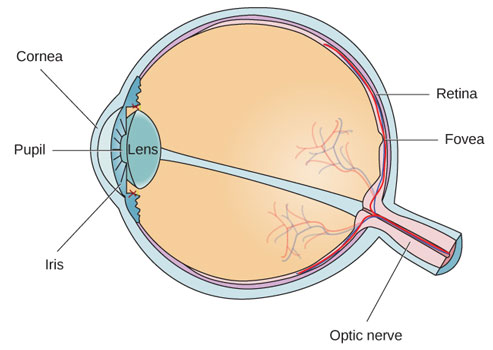
Using the diagram, look at the placement of the optic nerve. The optic nerve carries signals from the eye to the thalamus in the brain, but the point where it leaves the eye creates a "hole" in the retina.
This area is known as the blind spot, a place where there are no photoreceptors, and you literally cannot see. Everyone has a blind spot, but how does your brain accommodate for this gap in your visual field so that you don't notice it?
The Blind Spot
Your brain accommodate for this gap in your visual field in two ways:
- Because each eye has a different visual field, the blind spots do not overlap.
- Our visual system fills in the gaps in our visual field so that we never even notice it exists.
Textbook Reading #3
Read 5.3 Vision in your Psychology 2e textbook from OpenStax to review the concepts featured in this section of the lesson, but be aware that many of the perceptual concepts featured in the reading will not be covered until the next unit.
5.3 Vision
- Online Textbook
- PDF Version - pgs. 153-161
Color Vision and Visual Deficiency
Color Vision Theories
As you learned earlier in this lesson, we can detect color in only a small portion of the electromagnetic spectrum of energy, and two theories explain color vision correctly, but in different ways:
- trichromatic theory
- opponent-process theory
Trichromatic Theory
The earliest theory of color vision is the trichromatic theory. According to this theory, there are three cone types in the retina- red, green, and blue- and these three cone types then work together to produce the range of colors we see.
We see a specific color by comparing responses from the three kinds of cones, each of which is most sensitive to a short, medium, or long wavelength of light; for this reason, we see red, yellow, and green colors better because of their longer wavelengths compared to blues (short wavelength). This theory is supported by the color blindness that some people experience as they lack red, green, or blue cones, resulting in an inability to detect some colors.
Color blindness is a genetic condition and is usually diagnosed using an Ishihara test like the one below. The inability to distinguish red from green is the most common form of color blindness.
Color blindness typically presents as dichromatism (only two of the three primary colors can be detected) or monochromatism (complete color blindness in which all colors appear as shades of only one color).

Opponent-Process Theory
The second color-vision theory is the opponent-process theory. This theory differs from the trichromatic theory because it focuses on what happens in the brain, not the eye. It asserts that three opponent channels (red-green, blue-yellow, and black-white) are either stimulated or inhibited in succession with each other.
This theory helps to explain the phenomenon of afterimage, a visual sensation in which an image of the stimulus remains even after the stimulus itself is removed.
Afterimage

You can test the concept of afterimage using the image here. If you stare at the white dot for 30-60 seconds, then look at a white wall or piece of paper, you will see the negative afterimage with opposing colors.
What colors did you see after you looked away? How does this help reinforce the opponent-process theory?
Answer: The afterimage produces a red, white, and blue flag- these are the opposing colors of green, yellow, and black.
Vision
Watch the Crash Course: Anatomy and Physiology episode on "Vision" (9:38) for other examples of how visual processing occurs.
In some instances, we may experience problems in our vision. You learned above how nearsightedness and farsightedness occur, but there are other visual deficiencies can result from damage to the parts of the brain responsible for visual processing.
You may recall from an earlier lesson in this unit that the lower portion of the temporal lobes are responsible for some visual processing, especially the processing of patterns. People with damage to this part of the temporal lobes may experience agnosia, a condition in which familiar objects become unrecognizable.
One rare form of agnosia, prosopagnosia, is known as face blindness- people with this condition can recognize facial features, but cannot identify the person whose face it is, even the faces of people they know very well.
Another visual deficiency known as blindsight occurs when people have suffered damage to their primary visual cortex due to accidents or strokes and have lost the ability to see; however, they are still able to detect features like lines or angles of objects, without seeing the overall image.
For more information on how our brain determines what we "see", watch "Unconscious Vision" (3:36).
Auditory Processing
Audition
Audition is the biological process by which our ears process sound waves. Much like the light waves we receive and visually process, pressure waves are received and transduced by our auditory system into meaningful sounds.
Through the use of specialized body and brain areas, we can not only understand sound waves, but can also detect their original source and the source's direction.
Sound waves are vibrations of molecules traveling through the air. They move more slowly than light which explains why you can see lightning several seconds before you hear the thunder that accompanies it.
Sound Waves
In sound waves, amplitude (height of a sound wave) affects the loudness of a sound (measured in decibels dB) and wavelength (distance from the peak of one wave to the next) affects the pitch (or note) of a sound. Sound can be detected by humans in a range from 20 hertz (vibrations per second) to 20,000 hertz (Hz). Below you will see typical sound levels and their accompanying decibel levels.
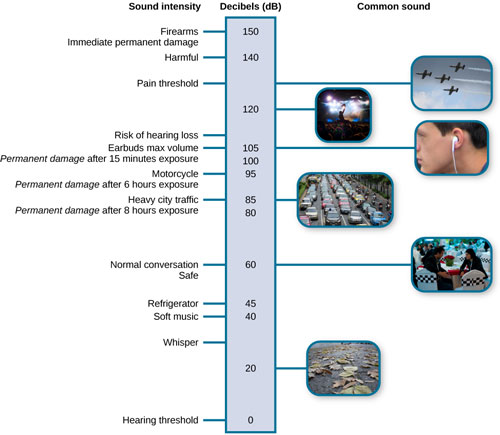
Structures of the Ear
The ear can be divided into three parts: the outer ear, the middle ear, and the inner ear. Read further to learn more!
Outer Ear
The outer ear consists of the pinna whose funnel shaped design allows it to catch sound waves and direct them into the auditory (ear) canal where they make the tympanic membrane, or eardrum, vibrate.
Middle Ear
The sound waves then travel to the middle ear where they vibrate three tiny bones known as the ossicles. These bones are called the hammer (malleus), the anvil (incus), and the stirrup (the stapes). They concentrate the vibrations of the eardrum on the oval window of the cochlea.
Inner Ear
The inner ear begins at the point where the stirrup meets the oval window of the cochlea, a small snail-shaped organ, and the inner surface of the cochlea, the basilar membrane, resonates to different sounds in different locations.
Transduction for hearing occurs when the hair (receptor) cells that line the basilar membrane convert vibrations into nerve impulses and send them to the auditory nerve.
From the auditory nerve, the neural signals travel to the thalamus via the brain stem before being routed to the temporal lobe's auditory cortex where the information will be processed and interpreted.
Sound Waves
The image below shows how each part of the ear connects to the next to conduct sound waves.
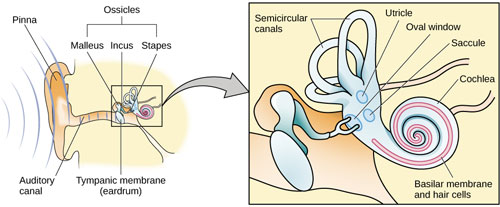
How Do We Interpret Sound?
Sound Theories
Three theories help explain how we perceive certain pitches or tones. Current research suggests that all three theories can be used to describe how pitch is perceived and that one is not more correct than the other. Read further to learn more!
Place Theory
The first theory to describe this process was place theory.
This theory says that higher and lower tones excite specific places on the cochlea along the basilar membrane and each place corresponds to a different pitch.
Frequency (Temporal) Theory
A second theory, frequency (temporal) theory suggests that as pitch rises, the entire basilar membrane vibrates at the same frequency.
The nerve impulses that match the frequency of the pitch traveling up the auditory nerve enables us to perceive pitch by decoding the frequency.
Volley Theory
The third theory, the volley theory, suggests that groups of auditory respond to a sound by firing action potentials slightly out of phase with one another so that when combined, a greater frequency of sound can be encoded and sent to the brain to be analyzed.
How We Locate Sounds
How do we locate sounds to determine where they are coming from? To determine a sound's location, your ears rely on two things: loudness, because louder sounds are usually closer, and the timing of when each ear receives the sound. If your left ear receives the sound first, the sound is likely coming from your left side.
Humans tend to be very accurate when identifying the location of sounds unless they come from directly in front of us, directly behind us, or directly above us. In these cases, the timing and intensity reach both ears simultaneously, making it difficult to determine their exact location.
Hearing Loss
In some instances, we cannot interpret sounds due to hearing loss. There are two types of hearing loss and they each occur in a different place. Read further to learn more!
Conduction Hearing Loss
The first type is conduction hearing loss in which there is poor conduction (transfer) of sounds from the tympanic membrane to the inner ear. This type of hearing loss is common, especially as people get older, and is often treated successfully with hearing aids.
Nerve (Sensorineural) Hearing Loss
The second type of hearing loss is nerve (sensorineural) hearing loss. This type of hearing loss is caused by damage to hair cells of the basilar membrane or the auditory nerve and can be present from birth but can also be caused by prolonged exposure to sounds above 120 decibels. Hearing aids don't work for this type of hearing loss because no auditory signals can reach the brain.
Cochlear Implants
People with nerve hearing loss can receive a cochlear implant, a device with an internal and external component.
The internal part is placed within the cochlea of the affected ear and the external part is placed behind the pinna to collect and process sounds and transmit them to the cochlear implant which then stimulates the auditory nerve.
This type of hearing loss can be present from birth but can also be caused by prolonged exposure to sounds above 120 decibels.
Textbook Reading #4
Read 5.4 Hearing in your Psychology 2e textbook from OpenStax to review the concepts featured in this section of the lesson, but be aware that many of the perceptual concepts featured in the reading will not be covered until the next unit.
5.4 Hearing
- Online Textbook
- PDF Version - pgs. 173-176
Watch the Crash Course: Anatomy and Physiology episode on "Hearing and Balance" (10:39) for examples of how we process sounds, sense pitch and the role our ears play in our sense of balance.
The Chemical Senses
Unlike vision, hearing, and touch, taste (gustation) and smell (olfaction) are chemical senses. Both taste and smell have sensory receptors that respond to molecules in the food we eat or in the air we breathe, creating a sensory interaction between them.
There are small bumps all over the surface of your tongue. These bumps, called papillae, are your taste receptors and they literally absorb the chemical molecules of everything we eat and drink. The more papillae you have, the more chemicals they absorb, resulting in a more intense taste. Gustation, or the sense of taste, has six sensations- sweet, salty, sour, bitter, umami (savory), and oleogustus (fat).
Recent research has confirmed that people with densely packed papillae on their tongues are supertasters, meaning they are more sensitive to the smallest changes in flavor.
On the other end of the spectrum are non-tasters prefer spicy and sweet foods because of their diminished sensitivity to flavors. Medium tasters would fall in the middle, having increased sensitivity to some flavors, but not all. These distinctions all reflect the number of papillae present on the tongue and that characteristic appears to be genetic.
The Sense of Smell
Of all the senses, smell (olfaction) is the most evocative (bringing strong images, memories, or feelings to mind) because smells tend to bring back emotional memories linked to a particular scent. Smell is also distinctive from the other senses because it is the only sense not processed first in the thalamus.
Olfactory receptors are found in the mucous membrane at the top of each nasal cavity. Odor molecules interact with the chemical receptors and send nerve signals to the amygdala and then on to the hippocampus, both components of the limbic system and involved in emotion and memory processing. This could explain why smells are linked to emotional memories.
Smell Diagram
Olfactory receptors are the hair-like parts that extend from the olfactory bulb into the mucous membrane of the nasal cavity.
An olfactory bulb is a bulb-like structure at the tip of the frontal lobe where the olfactory nerves begin.
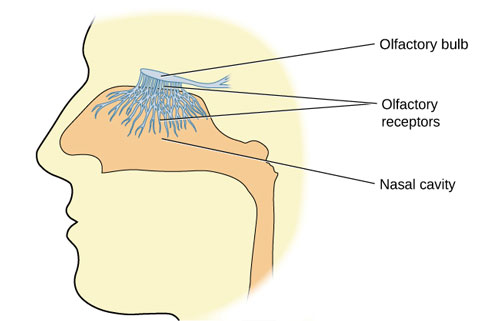
Pheromones
Pheromones are airborne chemical signals that animals can detect. For example, when dogs meet, they sniff each other, and male dogs usually know when a female dog is in heat (ready to mate). Pheromones are sensed by the vomeronasal organ in the nose and humans have this feature as well, meaning they are also susceptible to pheromones. This may explain why people are drawn to certain perfumes and other scents.
Our sense of smell peaks between the ages of 30-50 and declines thereafter, although women are able to smell more accurately than men at every age. This also means that our sense of taste declines, so we prefer less spice in our food as we age. Without the sense of smell, everything becomes bland, further demonstrating the strong sensory interaction between smell and taste.
Touch and the Body Senses
Somesthetic and Somatosensory
The skin senses, or somesthetic senses, allow us to feel pressure, light touch, pain, cold, and warmth. Inside the layers of the skin (the epidermis and dermis), there are several different receptors that sense pressure and multiple receptors that respond to changes in temperature. When we perceive something as "hot", it is because the skin receptors for both warm and cold are activated.
These signals are sent to the thalamus for processing and then on to the somatosensory cortex in the parietal lobe. Remember from earlier in this unit that the more receptors there are in a particular body area, the more space is devoted to it on the sensory cortex.
Pain
Pain is processed in both the body and the brain. We experience pain through receptors known as nociceptors, but the type and intensity of the pain determines how it is sensed and processed in the brain, body, and spinal cord. Although pain is unpleasant, it serves a vital function as a warning system that something is wrong.
One theory that attempts to describe the complexities of pain is the gate-control theory. According to this theory, there is a neurological "gate" in the spinal cord through which pain messages from different nerve fibers pass. If the gate is closed by one pain message, other pain messages may not be able to pass through, like a locked gate.
Phantom Limb Syndrome
Other factors can influence our experience of pain as well, such as fear, anxiety, and expectation. For example, if you expect a dentist visit to hurt and you are anxious about it, it is more likely that it will be more painful. Another type of pain experienced by some people is called phantom limb syndrome and refers to the pain amputees may experience in their missing limb.
Researchers don't know exactly what causes phantom limb pain to occur, but it seems to involve a "rewiring" in your brain and spinal cord resulting from the loss of sensory input signals from the missing part. As a result of no sensory input, the brain and spinal cord send pain signals as though something is wrong. The pain is real and not purely psychological; MRI scans show activity when the patient feels pain in areas of the brain that were previously connected to the nerves in the amputated limb.
The Body Senses
Two additional senses, known as the body senses, are the vestibular sense and the kinesthetic sense. Vestibular sense is rooted in the vestibular system of the inner ear and helps us to sense our balance, gravity, and the movement of our heads.
The semicircular canals in your inner ear are fluid-filled and movement of this fluid gives the brain a sense of where we are in space and helps us keep our balance. This is why sudden movements can momentarily disrupt your sense of balance, causing motion sickness.
Kinesthesis and proprioception work with our vestibular sense to help us control our movements and account for changes in our body position. Kinesthesis is our perception of our body's movement in space and proprioception is our perception of our body's position. In this way, our body senses work collaboratively to keep us balanced and moving.
Textbook Reading #5
Read 5.5 Other Senses in your Psychology 2e textbook from OpenStax to review the concepts featured in this section of the lesson, but be aware that many of the perceptual concepts featured in the reading will not be covered until the next unit.
5.5 Other Senses
- Online Textbook
- PDF Version - pgs. 164-168
Knowledge Check
Knowledge Check #1
Answer the following questions about sensation and perception.
Question #1
________ refers to the minimum amount of stimulus energy required to be detected 50% of the time.
- Absolute threshold
- Difference threshold
- Just noticeable difference
- Transduction
Answer: a. Absolute threshold
Question #2
Decreased sensitivity to an unchanging stimulus is known as ________.
- transduction
- difference threshold
- sensory adaptation
- inattentional blindness
Answer: c. sensory adaptation
Question #3
________ involves the conversion of sensory stimulus energy into neural impulses.
- Sensory adaptation
- Inattentional blindness
- Difference threshold
- Transduction
Answer: d. Transduction
Task
In this lesson, you learned about the senses.
Now you're going to answer questions about thresholds and a study.
Credits
Spielman, R. M., Jenkins, W. J., & Lovett, M. D. (2020). 5.1 Sensation versus Perception. In Psychology 2e (pp. 158-161). OpenStax. https://openstax.org/books/psychology-2e/pages/5-1-sensation-versus-perception
Spielman, R. M., Jenkins, W. J., & Lovett, M. D. (2020). 5.2 Waves and Wavelengths. In Psychology 2e (pp. 161-165). OpenStax. https://openstax.org/books/psychology-2e/pages/5-2-waves-and-wavelengths
Spielman, R. M., Jenkins, W. J., & Lovett, M. D. (2020). 5.3 Vision. In Psychology 2e (pp. 165-173). OpenStax. https://openstax.org/books/psychology-2e/pages/5-3-vision
Spielman, R. M., Jenkins, W. J., & Lovett, M. D. (2020). 5.4 Hearing. In Psychology 2e (pp. 173-176). OpenStax. https://openstax.org/books/psychology-2e/pages/5-4-hearing
Spielman, R. M., Jenkins, W. J., & Lovett, M. D. (2020). 5.5 Other Senses. In Psychology 2e (pp. 176-180). OpenStax. https://openstax.org/books/psychology-2e/pages/5-5-the-other-senses